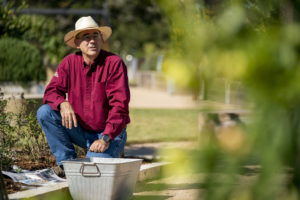How to manage garden weeds with mulch
Newspaper and mulch key to keeping weeds at bay
Managing garden weeds is a challenge all gardeners face, but Skip Richter, Texas A&M AgriLife Extension Service horticulture agent, Brazos County, and host of Garden Success, KAMU FM/HD-1, offers some advice to keep the weeds at bay that can be easily implemented with a bag of mulch and a few newspapers.

The importance of removing weeds
A weed is classified as any unwelcome plant in your garden. It could be an invasive plant, or just a volunteering plant of some sort, but if it is not something you want to grow in your garden area, then it may be considered a weed.
Aside from possibly not adding any beauty or benefit to your garden, weeds can take away water, nutrients, soil and sunlight from plants you wish to thrive in your garden area. Weeds may also harbor plant viruses or even attract pests that could then move on to your garden plants. As weeds grow larger, removing them by hand pulling or hoeing can disturb the roots of your garden plants.
Without proper maintenance or prep work, gardeners may find themselves pulling weeds year-round, when a few steps at the beginning of the season could significantly reduce or even eliminate your days of weed pulling all together.
How to manage your weeds
Mulch may offer protection from weeds in several different but similar ways. Mulch can help deter weeds, prevent surface crusting and minimize runoff. Organic mulches include leaves, pine needles, dried grass clippings, compost, shredded bark or other organic materials.
The first mulching option is simply to use an organic mulch on the soil surface.
“Weed seeds need light hitting the soil to germinate,” Richter said. “In fact, we say wherever sunlight hits the soil, nature plants a weed.”
By placing mulch over the surface, the sunlight is blocked out, which prevents weed seeds from getting started.
Mulch over newspaper
However, perennial weeds can push right through a light mulch, Richter said. So, for some perennial weeds and for germinating weed seeds, it helps to place newspaper on the soil surface to create more of a boundary between the soil and mulch to keep the sunlight from penetrating.

“When you put four to six sheets of newspaper down on the surface of the soil and then throw a mulch of leaves, dried grass clippings, compost, shredded bark or other organic materials on top of that, it will block out most weeds for the remainder of that particular gardening season,” he said. “It lasts about three or four months.”
A tip to keep in mind as you lay down the newspaper is to wet it as you lay it so that it does not blow away. Richter likes to lay the newspaper four to six sheets at a time and overlap it by a few inches. When you get to a plant, split the page, and lay the paper on either side of the plant. Then spray the newspaper with water and place the mulch over top.
After you have placed all the newspaper down with a mulch over the top, there should be no newspaper visible. The “mulch-over-newspaper” technique will keep weeds out, so you shouldn’t have to come back and do any more weeding any time soon. If a weed does appear, it may be due to a hole in the newspaper, so simply pull back the mulch, remove the weed and lay another piece of newspaper over the hole. Then cover it with the mulch.
The newspaper and organic mulch technique works well before weeds germinate but can also help capture lost ground by smothering young weeds before they get too large. It helps to wet the weeds and soil before laying the newspaper and mulch. Those young weeds will die and decompose under the newspaper cover, releasing their nutrients back to the soil.
For larger areas where you are not growing plants but just want to keep down the weeds, you can take it up a notch and use large sections of cardboard covered with leaves or even shredded branches to create a longer term weed block over the soil.
If mulching and weed control were helpful in the planning of your garden, be sure to look into raised garden beds, starting from seeds or transplants as well as how to choose the best fertilizers for your gardens.
For further information on growing vegetables, visit the Easy Gardening Series, or view the information on planting vegetables to get more on seeding and transplanting.
For more information on gardening, check out the Aggie Horticulture website, where there’s a wealth of free publications on all aspects of gardening from Texas A&M AgriLife.


